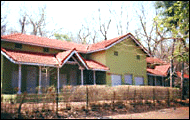
Buried under the French-Swiss border, the Large Hadron Collider has gotten its share of ink--and for good reason. Hearing about the sheer magnitude and price of what's been called the biggest and most expensive scientific experiment in human history is enough to instill fascination and excitement in even the most non-particle-physicists among us. Once it's running at full capacity, the project's researchers say, the $5.3 billion LHC, the biggest particle accelerator ever built, will be able to answer questions physicists never thought they'd get answers to, like why the universe formed the way it did and why matter has mass. Critics of the project say it could have the opposite effect, leading not to knowledge but instead humanity's demise.
Technicians plan to flip the switch on the collider this week, sending bunches of protons around the concrete tube dispersed with supercooled electromagnets, to create the very first collisions. Last month I visited CERN, the international nuclear research lab near Geneva that houses the LHC. The project's vital statistics jump out: an underground ring 16 miles in circumference will propel bunches of protons (about 100 billion at a time) around at almost the speed of light, more than 11,000 times per second. But it's an experiment unlikely to deliver its promised answers anywhere near as quickly as the protons are moving inside it.
From the beginning, a quick turnaround of findings was never the goal. It's fundamental, rather than practical, knowledge that researchers are after, as well as a suspected new particle called the Higgs boson (dubbed "The God Particle" for its potential to answer the most basic questions about existence, such as how anything came into existence) that could have unfathomable uses far into the future. Researchers liken the pursuit of the Higgs to the 1897 discovery of the electron, an atom's charged outermost particle. Its detection aided the harnessing of mass electricity, which has fueled core cultural components of the 21st century: the efficient lights we turn on, the TVs we watch and the phones we talk on. Another advance like that, CERN hopes, could be in store.
The collider will operate around the clock for nine months of the year: about 600 million collisions per second. Two floors of computer servers installed to measure LHC data will keep records of only a fraction of the collisions; the computers will discard the rest. There's also the style of explosion. Very few collisions are the same, so finding the most powerful ones that might show the existence of the Higgs particle or other unexpected effects will take time. By the estimate of Lyn Evans, the LHC's project head, big findings won't come for "a pretty long time." A junior researcher I spoke with was more descriptive. "It will definitely take months at a minimum--years, if nature is not kind to us," he said.
A bigger problem is likely to be collaboration. The number of scientists working collectively on each of the ring's four experiments--about 10,000--has made the project the biggest international collaborative research endeavor in history. It's certainly helpful to have so many qualified, knowledgeable voices, but the size of the roster also brings a downside. Ten thousand geographically dispersed scientists poring over loads of data means more, and longer, squabbling over whether a Higgs really is a Higgs. "We're very lucky to have so many voices on this project, but yes, there could be some extended debating," said James Gillies, head spokesperson for CERN. Even after scientists agree on what they see, it could take years of analysis to agree on what a finding means, and how someone could find a practical use for it.
Until the collider starts, there's plenty of debate to fill that gap. Walter Wagner, a researcher in Hawaii, started a group this year called Citizens Against the Large Hadron Collider, devoted to halting the machine's operation until more testing ensures its safety. "There is a real possibility of creating destructive theoretical anomalies such as miniature black holes, strangelets and deSitter space transitions," Wagner says in a statement on the group's Web site. "These events have the potential to fundamentally alter matter and destroy our planet."
CERN's top researchers see it differently. Says Evans, "Any physical collision that humans are capable of creating on earth has already been happening much more powerfully and frequently in the natural universe." Still, the prospect of creating loads of tiny but quickly growing alternate universes would certainly add a new allure to an experiment that's already pretty enthralling.












